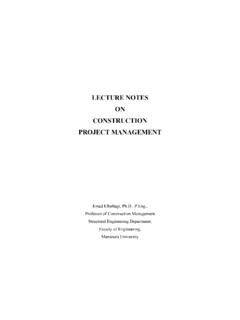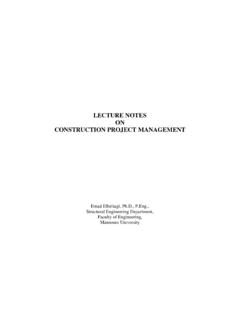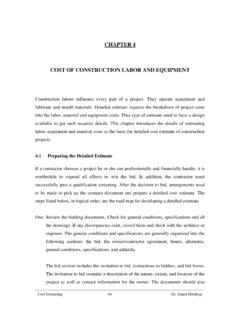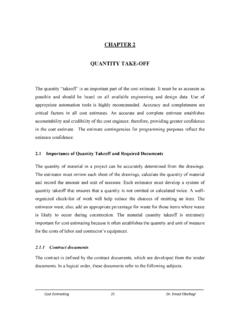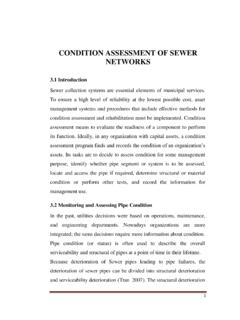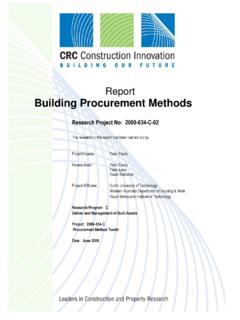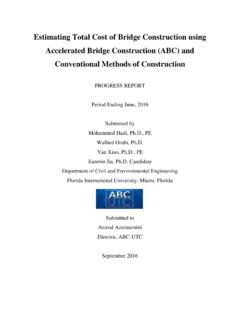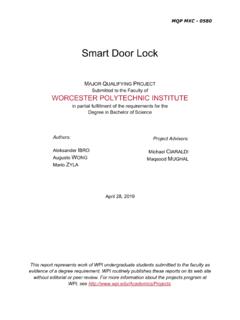Transcription of CHAPTER 2 CONTRACT STRATEGY
1 CHAPTER 2. CONTRACT STRATEGY . At the early stage of a project and once a project manager is selected, the main issue that faces the owner is to decide on the CONTRACT STRATEGY that best suits the project objectives. CONTRACT STRATEGY means selecting organizational and contractual policies required for the execution of a specific project . The development of the CONTRACT STRATEGY comprises a complete assessment of the choices available for the management of design and construction to maximize the likelihood of achieving project objectives. The scope of such contracts is very wide, from a simple purchase of standard article to multi-million- pound projects. The size and complexity of the CONTRACT matter vary accordingly. A proper CONTRACT STRATEGY for a project involves five key decisions: - Setting the project objectives and constraints - Selecting a proper project delivery method - Selecting a proper CONTRACT form / type - CONTRACT administration practices What is a CONTRACT A CONTRACT is defined as: "an agreement made between two or more parties which is enforceable by law to provide something in return for something else from a second party".
2 Contracts can be very simple or they may be very long and complicated legal documents. When a CONTRACT is properly set-up it is legally binding upon. The two parties are expected to perform the various obligations they have undertaken, as expressed in a mutually agreed set of CONTRACT documents. A CONTRACT therefore, is necessary to protect both client and contractor. According to its simple definition, a CONTRACT is an agreement Construction Management 19 Dr. Emad Elbeltagi enforceable at law, but not all agreements are contracts. Some elements must be present before an agreement becomes a CONTRACT . These elements are: - Competent Parties: For an agreement to be a CONTRACT , there must be two or more competent parties. In order to be considered competent, a part must have a certain legal standing. - Proper Subject Matter: For the subject matter of a CONTRACT to be proper, the first requirement is that it was be clearly defined as to the rights and obligations of each party.
3 Second, the purpose of the CONTRACT must not violate the law. - Consideration: There must be a lawful and valuable consideration given b both parties. A consideration often called "Something for Something." A consideration must, also, be possible. - Agreement: For valid CONTRACT , there must be a mutual agreement. An agreement is considered to have been reached when an offer made by one party is accepted by the second party. Both parties must wish and intend their bargain to be enforceable by law. - Proper Form: The terms of a CONTRACT must be written so that both parties are very sure of what their rights and responsibilities are. - Consent of the Parties: The agreement must be free from: Misrepresentation, Duress Undue influence, etc. The main steps to be taken before placing CONTRACT are presented in Fig.
4 Selection of CONTRACT Type The selection of CONTRACT type to be used for a construction project is made by the owner, acting upon the advice of his Engineer and his legal advisor. The selection must meet the owner Objectives and takes into account the constraints that might relate to the project . Consultants and contractors should be fully informed by the project objectives and constraints. The scope and the nature of the project will primarily affect the selection of type of CONTRACT . Construction Management 20 Dr. Emad Elbeltagi Identify project Prepare Scope Select CONTRACT Prepare Tender Documents Invite Tenderes Tender Meetings Revise and Evaluation Place CONTRACT Fig. : Steps of contracting process project objectives The client will have a number of overall objectives. These objectives may be of primary and/or secondary importance.
5 Primary objectives include functional performance, time objectives, and cost objectives. a. project Scope (performance): The project scope defines the extent or the area that the CONTRACT covers. Any additions or omissions during the life of the project will increase or decrease the quantity of work involved. Likewise, any changes in design must be discussed carefully to establish whether or not they are likely to affect the scope of the project . b. Time: The scope and time are closely interrelated. Decisions must often be made on the effect of increasing or decreasing scope on time. If the completion date of a project is critical, then increasing scope will call for an accelerated program. The extra cost associated with this acceleration must be quantified. Construction Management 21 Dr. Emad Elbeltagi c.
6 Price: The cost of a project is closely related to scope and time. The effect of the CONTRACT on price, and the various incentives and penalties that can help to keep price steady must be discussed and clearly defined. On the other hand, secondary objectives could arise on a construction project and would exert a major influence over CONTRACT STRATEGY decisions Examples of secondary objectives are: Allocation and payment for risk. Training of the client's staff. Transfer of technology. Involvement of contractor in design. Involvement of client in CONTRACT management. Choice of labor-incentive construction. Use of local material and resources. Protection of the environment. project constraints All construction projects have constraints that influence the achievement of the project objectives. These constraints should therefore, be considered when choosing an appropriate CONTRACT STRATEGY .
7 There are a variety of constraints and these are examples: Availability of funds. Availability of contractual incentives. Method of tendering. project location. Target dates of the project . Possibility of design changes. Availability of resources. Seasonal working. Number of contractors willing or able to tender. Inflation. Construction Management 22 Dr. Emad Elbeltagi Factors influencing CONTRACT choice Three main factors influence the choice of a given CONTRACT including: the incentive, risk sharing and the flexibility. project delivery methods The project delivery method translates what project parties are involved in the project and how they interact with each other and called also project organizational structure. The choice of an organizational structure should be related to project objectives and constraints.
8 It can be facilitated considering the following factors: Size and nature of the work packages within the project . Selection of the design team form in-house resources external consultants or contractors. Process of supervision of construction. Restrictions upon using combination of organizational structures within the project . Expertise which the client wishes to commit to the project . When plans are completed and the owner is interested in securing the low price, the use of competitive bids is suggested. The competitive bidding results in the type of CONTRACT that many are familiar with. A negotiated CONTRACT should be used when construction should start before plans are completed or when the many unknown factors of the project make an accurate estimate impossible. When many changes are expected and when inspection and supervision cannot be done efficiently, the negotiated type of CONTRACT should be used.
9 The various project delivery methods are summarized as follows: Traditional approach This is the most common approach in civil engineering projects in which the design has to be completed before construction can start. Design and construction are usually Construction Management 23 Dr. Emad Elbeltagi performed by two different parties who interact directly and separately with the owner. The pros and cons of this approach are summarized as follow: Advantages: - Price competition - Total cost is known before construction starts - Well documented approach used in most government projects. Disadvantages - Long time - Design does not benefit from construction expertise - Conflict between owner, contractor and A/E. Therefore, this method is fine in many cases where the project is clearly definable, design is completed, time need not be shortened, and changes are unlikely to occur during construction.
10 Direct labor In this approach, owner organization performs both the design and construction using its in-house labor force. - Used by large authorities - The owner performs both the design and the construction - May use consultants for some specialized designs - Most suitable for small projects - Can be used when expertise are available - Low risk projects - Inadequate scope definition Design-build In this approach, a single organization is responsible for performing both design and construction and, in some cases, providing certain know-how for the project . The pros and cons of this approach are summarized as follow: Advantages: Construction Management 24 Dr. Emad Elbeltagi - One CONTRACT that may include know-how - Minimum owner involvement - Used for fast-track projects in order to reduce time - Co-ordination between design and construction and easier in implementing the changes Disadvantages - Cost may not be known until end of the construction - High risk to contractor and more cost to owner - Design-build company may reduce quality to save cost The use of this approach, therefore, should be considered when contractors offer specialized design/construction/know-how expertise or when design is strongly influenced by the method of construction.
